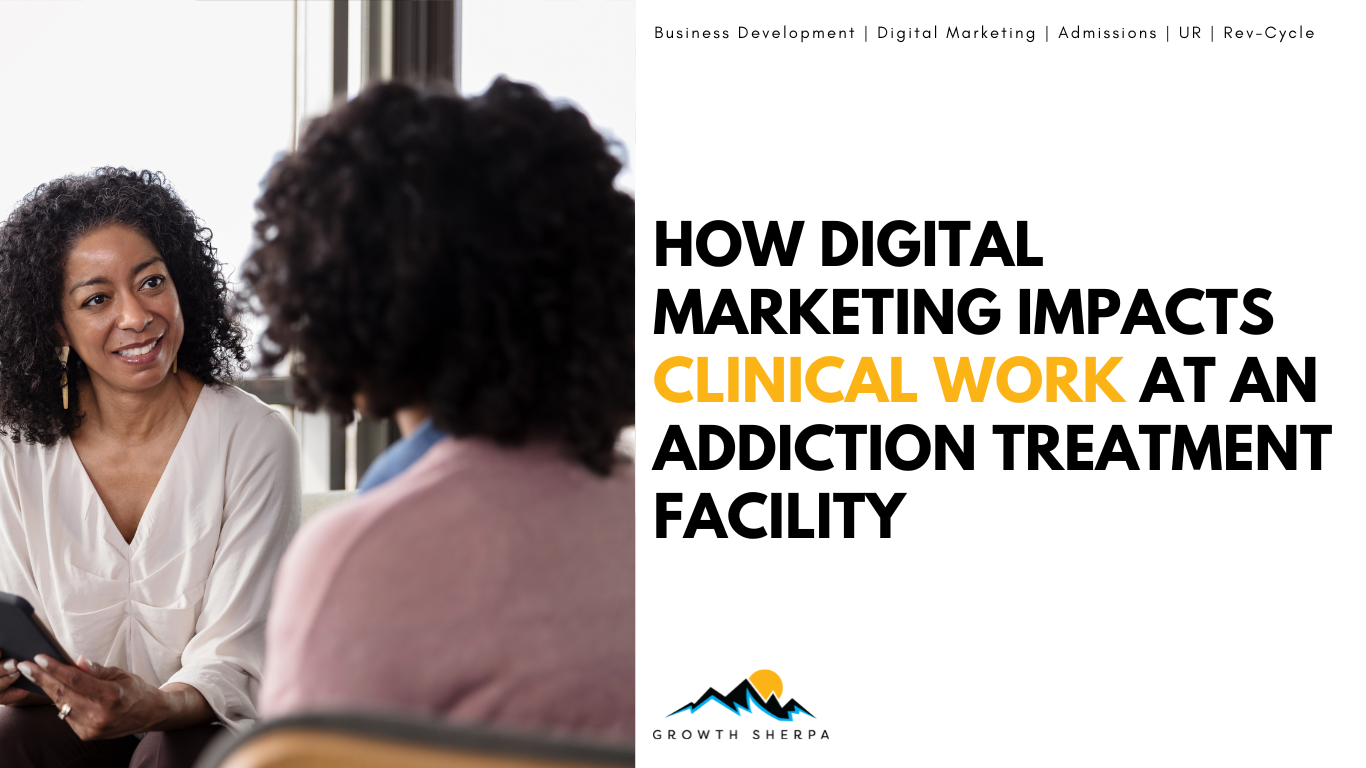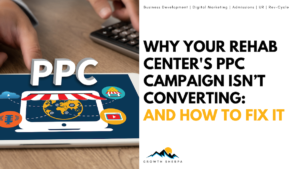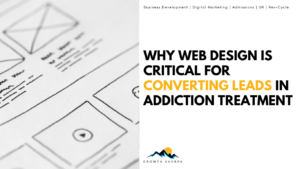At first glance, the relationship between digital marketing and clinical care in addiction treatment might not seem obvious. Marketing teams focus on impressions, leads, and campaigns. Clinicians concentrate on therapy sessions, diagnoses, and care plans. But in reality, these two departments are deeply connected. The work done by digital marketers shapes who walks through the front door of your facility, what expectations they carry, how they engage with treatment, and ultimately, what clinical staff are dealing with on a daily basis.
In a field as nuanced and sensitive as addiction treatment, that relationship can mean the difference between aligned success and operational chaos. A well-integrated marketing strategy does more than generate leads—it directly supports clinical excellence, enhances patient outcomes, and fosters a culture of clarity and cohesion within the facility.
Let’s explore the powerful and sometimes underappreciated ways that digital marketing impacts clinical work in addiction treatment settings, from admissions all the way to discharge and alumni relations.
First Impressions Shape Clinical Realities
The clinical journey begins long before a patient ever speaks to a therapist or sees a nurse. It starts online. The ads they click, the website they browse, the reviews they read, and the content they consume all form a mental picture of what your program promises.
If your digital marketing paints a picture of a luxury, spa-like retreat, but patients arrive to find a structured, evidence-based program grounded in clinical rigor, there’s going to be friction. That disconnect sets the stage for confusion, disappointment, and non-engagement. Your marketing team is not just selling beds—they’re setting expectations that your clinicians will inherit and manage.
When marketing accurately reflects the clinical experience, patients are more likely to trust the process, commit to the work, and engage meaningfully. That trust leads to better retention, fewer AMA discharges, and a smoother therapeutic alliance. Digital marketing that prioritizes honesty and clinical alignment lays the groundwork for stronger clinical outcomes.
Lead Quality Influences Clinical Cohesion
Many addiction treatment centers operate under relentless pressure to keep census numbers high. That pressure often falls hardest on marketing and admissions teams, who are tasked with driving a steady stream of leads and conversions.
But not all leads are created equal.
If digital marketing strategies prioritize sheer volume—broad, generic ads and vague promises—they may generate unqualified leads who are not clinically appropriate, lack insurance coverage, or are unprepared for residential care. Admissions teams then scramble to screen, and clinicians may be asked to “make it work” with patients who aren’t a true fit.
On the other hand, targeted digital campaigns that use condition-specific keywords, geography filters, payer-focused messaging, and clear descriptions of programming will generate fewer, but higher-quality leads. These are patients who align with the treatment model, are clinically appropriate, and are more likely to engage in care.
Higher lead quality means admissions can spend more time on fit and less time on filtering. Clinical teams aren’t put in a position of trying to bend their model to accommodate outliers. Everyone wins. Patients get the care they need. Clinicians work with cases they’re trained for. Marketing proves its value not just in volume, but in clinical compatibility.
Marketing Content Enhances Psychoeducation and Engagement
A major goal of clinical work in addiction treatment is to educate patients about the nature of addiction, mental health disorders, trauma, relapse, and recovery. Digital marketing content can reinforce and support this goal long before the first group session.
Think about the impact of a blog that breaks down the signs of trauma bonding or explains how co-occurring disorders affect addiction. If a prospective patient reads that content during their decision-making process, they arrive already primed with insight and language that complements the clinical process. They’re not starting from zero. They’re stepping into treatment with a mental framework that aligns with therapeutic goals.
Video content, podcasts, social posts, and downloadable resources are all tools that digital marketers can use to start the education process early. This eases the burden on clinical teams and accelerates the therapeutic journey. In essence, marketing becomes an extension of the care continuum, setting the stage for faster progress and deeper engagement.
CRM and Attribution Systems Shape Clinical Workflows
Modern addiction treatment facilities often use customer relationship management (CRM) tools and digital attribution systems to track lead sources, patient engagement, and conversion paths. These tools are essential for marketing teams to measure ROI, but they also touch clinical workflows in subtle but powerful ways.
For example, when admissions and clinical teams have access to the same CRM, they can see the full arc of a patient’s journey—from first click to intake to step-down care. This enables better handoffs, more informed clinical assessments, and coordinated care planning. If the CRM shows that a patient watched a trauma-focused webinar and downloaded a PTSD checklist, the therapist can use that information to open a conversation or build rapport.
Even small details—like the messaging a patient responded to or the pages they viewed most—can offer clues to their concerns, fears, or motivations. When digital systems are integrated thoughtfully across departments, marketing data becomes clinical insight.
Consistency Builds Trust Among Clinical Staff
When digital marketing efforts are chaotic, disjointed, or inconsistent with clinical messaging, it creates confusion not just for patients, but for staff. Clinical professionals may grow skeptical or frustrated if patients arrive misinformed or if marketing seems to make promises they cannot deliver.
This disconnect erodes morale, undermines team cohesion, and creates friction between departments.
On the flip side, when digital marketing is well-aligned with clinical values, it creates a sense of shared mission. Clinicians know what patients have been told. They trust that messaging will reinforce the treatment model rather than contradict it. That consistency builds mutual respect between marketing and clinical departments, encourages collaboration, and supports a healthy workplace culture.
Facilities that invest in cross-functional alignment—regular meetings between marketing and clinical leads, shared editorial calendars, mutual reviews of website and ad content—tend to experience fewer internal conflicts and more united care delivery.
Alumni Engagement Improves When Marketing and Clinical Teams Collaborate
The work of addiction treatment doesn’t end at discharge. Alumni programming, aftercare, and community-building efforts are essential to long-term recovery. Here again, digital marketing plays a crucial role in supporting clinical outcomes.
An engaged alumni program improves relapse prevention, provides peer support, and fosters ongoing accountability. But maintaining that engagement requires consistent communication, content creation, and digital outreach—tasks that naturally fall under marketing’s domain.
When clinical teams share insight into patient needs post-discharge, marketing teams can build content that speaks directly to those needs. Whether it’s email newsletters, alumni spotlight videos, or online support group promotions, the marketing team becomes a crucial ally in extending clinical care beyond the walls of the facility.
The result? Better long-term outcomes, stronger alumni networks, and a reputation that feeds the admissions pipeline with positive word-of-mouth referrals.
Branding and Messaging Influence Treatment Buy-In
Patients are not blank slates when they arrive at an addiction treatment center. They come with hopes, fears, skepticism, and assumptions—many of which have been shaped by your brand messaging.
If your digital marketing emphasizes quick fixes, miracle cures, or soft, motivational language, you may unintentionally encourage surface-level commitment. Conversely, if your messaging is honest about the hard work of recovery and highlights the depth of clinical care, you attract patients ready for transformation.
This is not just about branding for branding’s sake. It’s about psychological preparation. Patients who buy into a brand that aligns with real clinical work are more likely to complete programming, less likely to sabotage their own progress, and more open to clinical feedback.
Marketing creates the frame. Clinical care fills it in. If the frame is misaligned, the picture never quite fits.
Admissions Staff Feel the Difference
Marketing drives calls. Admissions closes them. But what many facilities forget is how heavily clinical staff rely on admissions to set the tone for care. And admissions, in turn, relies on marketing to deliver the right kind of calls in the first place.
If your digital campaigns are optimized for volume at the expense of clarity, your admissions team ends up in a constant state of triage. They spend valuable time weeding out bad fits, fielding angry questions from misinformed leads, and trying to make clinical decisions without clinical context.
That leads to burnout, turnover, and inconsistent handoffs—all of which ripple into clinical care.
But if your marketing efforts include clear payer information, transparent program descriptions, and condition-specific landing pages, admissions has a fighting chance to do their job well. They can move from reactive to strategic. And when that happens, clinical staff get the right patients, at the right time, with the right expectations. That’s the foundation for real treatment success.
Data and Insights Help Clinical Teams Evolve
Digital marketing generates a wealth of data—demographics, behavioral trends, engagement metrics, conversion rates, content performance. Much of that data can help clinical teams evolve their practices and better serve patients.
For instance, if marketing sees a spike in traffic to blog posts about trauma and grief, that may indicate a growing need among your patient base. Clinical directors can use that insight to adjust group topics, introduce new modules, or train staff in relevant modalities.
If paid ads targeting veterans perform well, perhaps there’s an opportunity to build a veterans-focused track or collaborate with referral sources in that community. The feedback loop between marketing data and clinical programming can become a powerful engine of innovation and responsiveness.
The key is for both departments to stop working in silos and start sharing insights. Marketing data is not just a business metric. It’s a clinical resource.
When Marketing and Clinical Work Together, Everybody Wins
The most successful addiction treatment facilities are those that recognize digital marketing as a clinical partner, not just a business function. When these two departments collaborate, they create a seamless patient experience—from online discovery to intake to treatment to aftercare.
Clinicians get patients who are motivated, informed, and appropriate for the level of care. Admissions operates with clarity and confidence. Marketing proves its value not just with filled beds, but with filled beds that stay full, achieve outcomes, and build lifelong brand advocates.
It’s a virtuous cycle. Clear messaging leads to aligned admissions. Aligned admissions support strong clinical work. Strong clinical work leads to positive outcomes. Positive outcomes fuel great reviews and referrals, which feed your digital marketing engine.
Digital marketing for addiction treatment isn’t just about clicks. It’s about clinical success. And when you treat it that way, the results speak for themselves.




